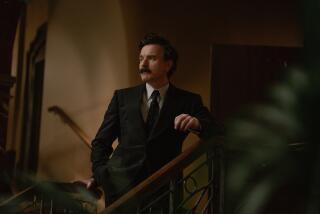Looking for Lenin, an American in Moscow
- Share via
MOSCOW — An American cannot help but be stunned at Vladimir I. Lenin’s omnipresence here. Cities, factories, subways, statues, even paperweights, bear his name or image. And for more than 60 years, Soviet leaders, espousing widely divergent policies, have wrapped themselves in his mantle.
In America the equivalent would be Washington, Jefferson, Lincoln and, yes, Jesus Christ in one package. For me, the endless repetition deadens any feeling, any ability to understand who Lenin was and what he means to the Soviet people.
But there are other ways a visitor can search. I was 13 when I stood in the mile-long, wind-whipped line waiting to pay respects at Lenin’s tomb. Fur-capped people moved in silence over Red Square’s foot-worn cobblestones. Inside, we headed down, pressed close, the only sound the muffled shuffling of feet. That dark corridor held a potent blend of reverance, religion and suffering, and something else--the irresistible force of a human mass, moving slowly forward.
In college, I read Lenin. I was unprepared for this rare, coldly analytical yet fiercely passionate mind that took abstract, complex concepts and shaped them, irreversibly, into spears.
In 1986 I drove with a Soviet companion to Leninsky Gorky, Lenin’s summer retreat, the site of his long convalescence and death. A footpath led to the white and green of summer birches and thick, moist air. Instantly, one knew why this man of revolution had come here--for peace, the soft feel of Russian meadows stretching forward and back in time without end. A fleshy young guide greeted us in reverential tones.
In the servants’ quarters of a czarist general’s former residence, he showed us a tiny room. A stiff-backed single bed, light-colored dresser on the right. In the far corner, a chair and writing table. One could see Lenin working there, that mind burning into the uncharted course, searching, discarding, finding, moving on. The next room, with more air, was his wife’s. One felt her, too, working, waiting. The photos show her serious and caring in 1921, grim and knowing in ’22.
The guide’s soft voice droned on with sanctified, simplified gospel, wildly out of place in Lenin’s fiery presence. A small, black table: “Here is where they dined with government and party leaders--Dzerzhinsky, Stalin, Molotov.” And the later dissidents--such as Nikolai I. Bukharin? Those men later purged by Josef Stalin, weren’t they here too, struggling to shape tomorrow? The guide did not say.
Then, on to the big house where Lenin lived, disabled. In a room of mementos lay a fine Belgian shotgun, a well-used hunter’s gun. A hunter myself, I appreciated Lenin’s choice of arms. “Oh, yes,” I said, “I remember reading somewhere that Lenin was a hunter.”
“Lenin enjoyed nature,” said the guide, “but we do not know if he actually killed anything.” I stared at him in disbelief. This man knew everything about Lenin-- how fast he read, how many articles he wrote, what he ate and when he went to bed. Why this absurd omission? Had hunting become awkward in polite Soviet circles, much as it has in New York?
On the broadly sweeping stairs, an added hand-rail brought Lenin back to life, clinging to it, struggling to climb. In the next room, photographs, wall high: The snaking mass of peasants, black against the drifted snow, carried Lenin’s coffin to the train in 1924. A roaring, pressing silence, as at the mausoleum lines decades later, saying with no mistake that this man’s life cut to the center of their being.
At the train station the tense mass with blurred faces surrounded the casket, waiting uneasily. “There is Molotov,” the guide said, pointing at a mustached face. “And here is Stalin.” Yes, I saw his profile next to the coffin, sharp and clear among the indistinct faces. Another room proclaimed: “Lenin Lives!” Lifeless statistics and photos of suited faces. “At the 27th Congress of the Communist Party of the Soviet Union, the uncompromising traditions of the great Lenin were carried out.” Had the caption read the same for the 24th, 25th and 26th, now so sharply criticized? Walking out, I asked where the pictures are of dissident Bukharin and others. “Oh, they are not here,” the guide said, his smooth, patronizing voice unchanged. “They are kept in Moscow. Goodby.”
Just before this current visit, I found the book in my library. I had bought it in Moscow in 1960: “On the Trail,” nonfiction hunting stories by Ivan Aramilev. The last chapter describes a grouse hunt taken by a veteran guide--and Lenin. The guide tells how Lenin, too long between hunts, hurried shots at rising birds--and missed. A serious hunter frustrated at his own ineptitude, he took the old man’s advice grudgingly and began to hit. And when Lenin walked in behind the rigidly pointing dog, his breath came in excited gasps and his legs shook.
I know Lenin a little better now. Well enough to feel certain he would say it was essential that Bukharin, Leon Trotsky and all the others take their rightful, complex and contradictory places in Leninsky Gorky and Soviet history. He would, without personal pride, understand the human truths carried in the massive mausoleum lines. As both a leader and serious hunter, he would take some small satisfaction, after suffering decades of imposed godliness, to know it was recalled that his legs trembled when he walked in on a covey of grouse.
More to Read
Sign up for Essential California
The most important California stories and recommendations in your inbox every morning.
You may occasionally receive promotional content from the Los Angeles Times.










